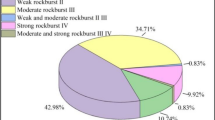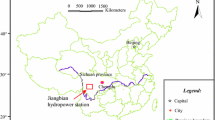Abstract
In view of complexity and uncertainty of problems in the prediction of rockburst, a classified prediction model of rockburst using rough sets-normal cloud is established. Seven main influencing factors including uniaxial compressive strength of rock σc, uniaxial tensile strength of rock σt, maximum tangential stress of surrounding rock σθ, rock integrality coefficient kv, ratio between uniaxial compressive strength of rock and uniaxial tensile strength of rock σc/σt, ratio between maximum tangential stress of surrounding rock and uniaxial compressive strength of rock σθ/σc and rock elastic deformation energy index wet are selected as the evaluation index of rockburst. Sixteen groups of rockburst examples at home and abroad are used as model construction samples. Then, the weight value of evaluation index of rockburst is obtained by rough sets and fuzzy sets. According to normal cloud theory and classification standard of rockburst, the cloud maps of evaluation index of rockburst are generated. Based on the normal cloud generator and sample data, the evaluation index of the classified sample is determined, and the comprehensive determination of evaluation index of the classified sample is obtained by combining the weight of the evaluation index of rockburst. Finally, the rockburst level is identified according to the principle of maximum membership degree. The classified prediction model of rockburst is used to predict five groups of rockburst samples at home and abroad, and the rockburst classification is coincident with the actual situation. The results show that the classified prediction model of rockburst using rough sets-normal cloud has great practicability.

Similar content being viewed by others
References
Yang J, Li X, Zhou Z et al (2010) A fuzzy assessment method of rock-burst prediction based on rough set theory. Met Mine 39(6):26–29
Nanyan H, Ye Y, Yaqi L et al (2018) Improved unequal-interval grey verhulst model and its application. J Grey Syst 30(1):175–185
Zhou J, Li X, Shi X (2012) Long-term prediction model of rockburst in underground openings using heuristic algorithms and support vector machines. Saf Sci 50(4):629–644
Ye Y, Yao N, Wang Q et al (2010) A method of ranking interval numbers based on degrees for multiple attribute decision making. J Intell Fuzzy Syst 30(1):211–221
Adoko AC, Gokceoglu C, Wu L et al (2013) Knowledge-based and data-driven fuzzy modeling for rockburst prediction. Int J Rock Mech Min Sci 61:86–95
Qian Q (2012) Challenges faced by underground projects construction safety and countermeasures. Chin J Rock Mech Eng 31(10):1945–1956
Shigen F, Zhang X, Li H (2016) Characteristics and prevention control measures of rock burst in excavation of ultra-deep shaft. J Saf Sci Technol 12(12):48–52
Zhao G, Liu Q, Liu C (2010) Bayes discriminant analysis for classification and prediction of rockburst intensity. Met Mine 39(5):143–147
Yang Y, Deng H, Songtao Yu (2017) Prediction of rockburst classification based on random forest. Min Metall Eng 37(4):23–27
Jianhua H, Shang J, Zhou K (2013) Improved matter-element extension model and its application to prediction of rockburst intensity. Chin J Nonferrous Met 23(2):495–502
Liu C, Yi J, Jiang D et al (2007) Study on rockburst intensity prediction method based on gray relational analysis theory. China Min Mag 16(12):100–103
Wei H, Yang X, Zhou H et al (2011) Study on rock burst prediction method based on gray relational analysis theory. Yangtze River 42(9):38–42
Zhang G, Gao Q, Juqiang D et al (2013) Rockburst criterion based on artificial neural networks and nonlinear regression. J Cent South Univ (Nat Sci Ed) 44(7):2977–2981
Zhang L, Zhang D, Li S et al (2012) Application of RBF neural network to rockburst prediction based on rough set theory. Rock Soil Mech 33(Supp. 1):270–276
Min H, Chen J, Yugen L (2011) Research on rockburst prediction based on BP neural network and GA. Min Res Dev 10:90–94
Chen P, Hongming Yu, Shi H (2014) Prediction model for rockburst based on weighted back analysis and standardized fuzzy comprehensive evaluation. Chin J Rock Mech Eng 33(10):2154–2160
Jia Y, Lv Q, Shang Y et al (2014) Rockburst prediction based on evidence theory. Chin J Geotech Eng 36(6):1079–1086
Yang G, Chen C, Gao S et al (2015) Study on the height of water flowing fractured zone based on analytic hierarchy process and fuzzy clustering analysis method. J Min Saf Eng 32(2):206–212
Jianzhong Xie Yu, Yang QC et al (2015) Demand forecasting model for short life cycle products based on improved BASS model. Comput Integr Manuf Syst 21(1):48
Jing W, Xiaoyan W, Gao Z (2010) Fuzzy comprehensive evaluation of simulation credibility based on fuzzy clustering analysis and rough sets theory. Syst Eng Electron 32(4):770–773
Yang G, Liu D, Chu F et al (2015) Evaluation on risk grade of tunnel collapse based on cloud model. J Saf Sci Technol 11(6):95–101
Chen Y, Liu D, Zhu D et al (2015) Comprehensive safety evaluation of ship ammunition depot based on cloud model. J Saf Sci Technol 11(2):138–144
Zhang B (2017) Rockburst prediction of deep buried tunnels based on projection pursuit analysis-normal cloud model. Yellow River 39(9):121–124
Chen J, Meng J (2016) Normal cloud model for rockburst intensity forecast and its application. Yangtze River 47(15):82–86
Zhou K, Lin Y, Jianhua H et al (2016) Grading prediction of rockburst intensity based on entropy and normal cloud model. Rock Soil Mech 37(Supp. 1):596–602
Wang Yu, Qiang X, Chai H et al (2013) Rock burst prediction in deep shaft based on RBF-AR model. J Jilin Univ (Earth Sci Ed) 43(6):1944–1949
Wang Y, Shang Y, Sun H (2010) Research and application of rockburst intensity prediction model based on entropy coefficient and ideal point method. J China Coal Soc 35(2):218–221
Acknowledgements
This work was funded by the study on the “Five High” Risk Identification and Control System of Enterprises (No. 149hubei-0002-2017AQ) and Hubei Province Safety Production Special Fund Project (2017HBAQZX).
Author information
Authors and Affiliations
Corresponding author
Ethics declarations
Conflict of interest
None.
Rights and permissions
About this article
Cite this article
Liu, R., Ye, Y., Hu, N. et al. Classified prediction model of rockburst using rough sets-normal cloud. Neural Comput & Applic 31, 8185–8193 (2019). https://doi.org/10.1007/s00521-018-3859-5
Received:
Accepted:
Published:
Issue Date:
DOI: https://doi.org/10.1007/s00521-018-3859-5




